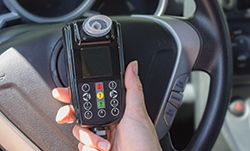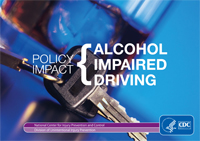Publications
In 2018, 12 million Americans aged 16 and older reported driving under the influence of marijuana and 2.3 million reported driving under the influence of illicit drugs other than marijuana during the past 12 months. Driving under the influence of drugs and alcohol is a serious public health concern that needs to be better addressed to safeguard the health and safety of everyone on the road.

Arizona legalized medical marijuana in April 2011. This study examined marijuana and alcohol use trends among injured drivers aged 16 and older who were evaluated at Level I trauma centers in Arizona, before and after medical marijuana was legalized in the state. The study found that during 2008–2014, of the 30,083 drivers treated at Level I trauma centers, 2,590 tested positive for marijuana; of these, 1,087 (42%) also tested positive for alcohol. Among 23,186 injured drivers with alcohol (BAC) results, 5,266 (23%) exceeded the legal limit for their age. Overall, medical marijuana legalization was associated with a small but significant increase in positive tests for marijuana and alcohol. Despite the small annual post-law increases in marijuana-positive drivers compared with the pre-law trend, alcohol-impaired driving remains a greater threat to road safety in Arizona.


- Jones JM, Shults RA, Robinson B, Komatsu KK, Sauber-Schatz EK. Marijuana and alcohol use among injured drivers evaluated at level I trauma centers in Arizona, 2008-2014external icon. Drug and Alcohol Dependence 2019; 204. 107539. DOI: 10.1016/j.drugalcdep.2019.06.041.
- Shults RA, Jones JM, Komatsu KK, Sauber-Schatz EK. Alcohol and marijuana use among young injured drivers in Arizona, 2008-2014external icon. Traffic Injury Prevention 2019; 20(1): 9-14. DOI: 10.1080/15389588.2018.1527032.
- Jewett A, Peterson AB and Sauber-Schatz EK. Exploring Substance Use and Impaired Driving Among Adults Aged 21 Years and Older in the US, 2015external icon.Traffic Injury Prevention 2018, DOI: 10.1080/15389588.2018.1479525
- Downs Jonathan, Shults RA, West Bethany. Attitudes toward mandatory ignition interlocks for all offenders convicted of driving while intoxicatedexternal icon. J Safety Res 2017 DIO:10.1016/j.jsr.2017.08.002.
- Voas, R. B., Tippetts, A. S., Bergen, G., Grosz, M. and Marques, P. Mandating Treatment Based on Interlock Performance: Evidence for Effectivenessexternal icon. Alcohol Clin Exp Res 2016; 40: 1953–1960. doi:10.1111/acer.13149
- Xiao D, Ye P, Li Y, Duan L, Wang L, Shults RA, Roehler DR, Yee SL. Prevalence of drink-driving among adults in China: a nationally representative survey in 2010external icon. Traffic Inj Prev 2016 DOI:10.1080/15389588.2016.1161760
- Haegerich TM, Shults RA, Oman RF, Vesely SK. The Predictive Influence of Youth Assets on Drinking and Driving Behaviors in Adolescence and Young Adulthoodexternal icon. The Journal of Primary Prevention 2016. DOI: 10.1007/s10935-016-0418-7.
- Sebego M, Naumann RB, Rudd RA, Voetsch K, Dellinger AM, Ndlovu C. The effect of alcohol and road traffic policies on crash rates in Botswana, 2004-2011: a time-series analysisexternal icon. Accident Analysis & Prevention 2014; 70: 33-39.
- Bergen G, Lacey J, Romano E, Shults RA, Yao J. Characteristics of designated drivers and their passengers from the 2007 National Roadside Survey in the United Statesexternal icon. Traffic Injury Prevention 2014; 15: 273-277.
- Bergen G, Pitan A, Qu S, Shults RA, Chattopadhyay S, Elder R, et al. Publicized sobriety checkpoint programs: A Community Guide systematic reviewexternal icon. Am J Prev 2014; 46: 529–539. 10.1016/j.amepre
- Quinlan K, Shults RA, Rudd RA. Child passenger deaths involving alcohol-impaired drivers: national and state patternsexternal icon. Pediatrics 2014; 133: 966-972.
- Dellinger AM; West BA. Healthcare providers and teen driving safety: topics discussed and educational resources used in practiceexternal icon. American Journal of Lifestyle Medicine 2014.
- Sauber-Schatz EK, Ederer DJ, Dellinger AM, Baldwin GT. Vital Signs: Motor Vehicle Injury Prevention — United States and 19 Comparison Countries. MMWR Morb Mortal Wkly Rep. ePub: 6 July 2016. DOI: http://dx.doi.org/10.15585/mmwr.mm6526e1external icon
- Jewett A, Shults RA, Banerjee T, Bergen G. Alcohol-Impaired Driving Among Adults – United States 2012. MMWR 2015; 64(30): 814-817.
- Shults RA, O’Malley Olsen E. Vital Signs: Drinking and Driving Among High School Students Aged ≥16 Years — United States, 1991–2011. MMWR 2012; 61(39);796-800.
- Bergen, G, Shults RA, Rudd RA. Vital Signs: Alcohol-Impaired Driving Among Adults — United States, 2010. MMWR 2011; 60(39);1351-1356.

(July 2016) – Reducing motor vehicle crash deaths was one of the great public health achievements of the 20th century for the US. However, more than 32,000 people are killed and 2 million are injured each year from motor vehicle crashes. In 2013, the US crash death rate was more than twice the average of other high-income countries. In the US, front seat belt use was lower than in most other comparison countries. One in 3 crash deaths in the US involved alcohol-impaired driving, and almost 1 in 3 involved speeding. Lower death rates in other high-income countries and a high percentage of risk factors in the US suggest that we can make more progress in reducing crash deaths.
(October 2012) – The percentage of teens in high school who drink and drive has decreased by more than half since 1991,* but more can be done. Nearly one million high school teens drank alcohol and got behind the wheel in 2011. Teen drivers are 3 times more likely than more experienced drivers to be in a fatal crash. Drinking any alcohol greatly increases this risk for teens.
Research has shown that factors that help to keep teens safe include parental involvement, minimum legal drinking age and zero tolerance laws, and graduated driver licensing systems. These proven steps can protect the lives of more young drivers and everyone who shares the road with them.
*High school students aged 16 years and older who, when surveyed, said they had driven a vehicle one or more times during the past 30 days when they had been drinking alcohol.
(October 2011) – US adults drank too much and got behind the wheel about 112 million times in 2010. Though episodes of driving after drinking too much (“drinking and driving”) have gone down by 30% during the past 5 years, it remains a serious problem in the US. Alcohol-impaired drivers* are involved in about 1 in 3 crash deaths, resulting in nearly 11,000 deaths in 2009.
Alcohol-impaired driving is never OK. Choose not to drink and drive and help others do the same.
*These drivers had blood alcohol concentrations of at least 0.08%. This is the illegal blood alcohol concentration level for adult drivers in the United States.
The Policy Impact: Alcohol Impaired Driving brief was published in February 2011. Therefore, this web page is provided for reference purposes only. The most current CDC data can be found on the Impaired Driving: Get the Facts page.
Each year, millions of people choose to drive while under the influence of alcohol, sometimes with devastating results. These deaths and injuries are preventable. Research has identified proven policies that can keep alcohol-impaired drivers off the road and save thousands of lives each year.

Policy Impact: Alcohol Impaired Drivingpdf icon (February 2011)